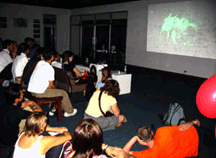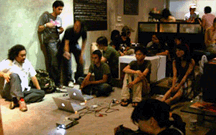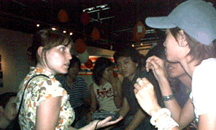Isabel
Saij (hereafter, IS): Can you present the "Thailand New Media
Festival 2004 to us?"
Francis Wittenberger (hereafter, FW): "Thailand
New Media Art Festival" (MAF-04 Bangkok) is organized and produced
by ICECA Thailand (Initiative for Cultural Exchange and Computer Arts).
http://thailand.culturebase.org/MAF04
MAF-03 was the pioneer Media Art Festival in Thailand and MAF-04 marks
it as an annual event.
http://thailand.culturebase.org/festival2003
http://thailand.culturebase.org/documentation.html
MAF combines a Cultural Exchange Programme featuring international
visiting artists, screenings and interactive computer art exhibitions.
http://thailand.culturebase.org/MAF04/docu_pic/maf04-docu-01.htm
http://thailand.culturebase.org/MAF04/docu_pic/maf04-docu-02.htm
http://thailand.culturebase.org/MAF04/docu_pic/maf04-docu-03.htm
http://thailand.culturebase.org/MAF04/docu_pic/maf04-docu-04.htm
http://thailand.culturebase.org/MAF04/docu_pic/maf04-docu-05.htm
http://thailand.culturebase.org/MAF04/docu_pic/maf04-docu-06.htm
The Festival is not meant
to be a singular event but rather an event in a series throughout the
year.
http://thailand.culturebase.org/activity.html
http://thailand.culturebase.org/events/sfx
The main idea behind ICECA and MAF is to introduce new media and
computer arts in Thailand, where cultural heritage is a national
treasure. In
Thailand, technology has already arrived in every corner of life but
art in Thailand is still a thing closer to “crafts.“
Soon after I’d made my first project in Thailand, I saw the creativity
of Thai artists, and I realized the potential they have to greatly influence
the global media scene. This is why I thought that it was important to
stay here and setup ICECA.
ICECA is not a formal institution, but it has stepped into close alliance
with various Thai institutions and international cultural organizations
active in Thailand.
ICECA also maintains workshops and presentations, which are currently
being extended; InFoMAT (International Forum for Media Artists and
Theorists) and NEXUS offer general Thai audience occasions to interact
with cutting
edge, digital media artists and international media artists who offer
and partake in Cultural Exchange projects via fusion of artistic networks. Beyond
the annual Festival--which exposes a large volume of international new-media
arts in Thailand "MAF-DNL" -- the festival's Digital
Network Library is a permanent collection conserving and offering access
to a part of the festival's collection authorized for this purpose
by the authors. The content is currently presented as part of the Alliance
Francaise's Library/computer-lab in Bangkok, and final negotiations
will
soon allow DNL to become a permanent part of the Srinakarinwirot University's
Central Library.
IS: How did you come to manage/curate a new media festival in Thailand?
FW: My first encounters
in Thailand were in 1989. That time my interest was in audio recording
studios. It took me 12 years to return and stay longer then a month.
In 1996, artist Boris Svirsky and I were working on a software-art
project "SEC" (Secondary Consciousness) http://uco.org.il and a thread of SEC became "Oman Robot" (http://oman.berlin.heimat.de),
a globe-trotting robot in a wheel-chair. Oman got invited to Eu-Ka-Beuk
exhibition in North Thailand and this is how it all started. Oman robot
was broken by the Thai customs while examining "art containing
a computer." Oman was broken and in my attempt to fix it for the
exhibition at the Chiangmai Art Museum, I met with Thai art students.
The students were fascinated buy the idea of a tech-art project and
I was fascinated by their interest and skills.
Less then two months later I returned from Europe with a grant by
Kunstpunkt Berlin (www.Kunstpunkt.com)
to realize ICECA. After several month of successful activity,
ICECA sponsors came to Chiangmai
to evaluate the project, and I presented a project that even
further
extended ICECA's cultural exchange activities and raised the international
profile. The project was called "Thailand First New Media Art
Festival," and
it was a three week long event spanning from March of 2003 to April.
It was a very difficult project to realize, especially since there
was no funding and the CMU did not understand what new media was, but
the
work was very rewarding; afterall, the timing was perfect (overlapping
the Thai New Year celebrations, over 4000 visitors came to the Festival).
It did not take long until the CM University realized the huge interest
of local audience in new-media arts.
IS: What are
the differences between managing/curating a festival in Thailand and
in Europe?
FW: The main differences between managing/curating a festival in Thailand and
in Europe are numerous. In Thai culture, people are indirect--saying "no" is
almost never used. This means that for any question asked, you might get
a "yes," "interesting," "we will give you an answer
soon," etc. So without knowing certain cultural codes, a producer
will face an invisible wall, and find out too late that the "yes" was
in fact a "no." For example, when a proposal is made, an answer
may be pending endlessly.
Art equals
craft in Thailand. There is almost no art in the same sense as we use
it in Europe; the general public has never heard of a museum and a
gallery is a place where tourist buy some colorful reproductions or
local craft/traditional art. When it comes to introduction of new-media
art, it’s very difficult to explain. Literally translated, "sue-sillapa" will
mean 'media art,' but media equals mass media (newspaper, TV and radio)
and art means craft; so most people will think you are talking about
'design;' and this is in the better case.
Visitors are interested and I do not fear their hands. In Europe, one will
have to put signs of "do not touch" or "touch here--this
is interactive;"in Thailand, people will not touch things that look
fragile and will not break anything at all. Also, safety issues are different--the
regulations of what is possible to present are kind of different. For example,
a 220 Volt power cable can normally lay on the floor and that is not a
problem, or an artist may perform live and close to the audience using
a disk-saw or any other “violent“ tool. When it comes to computers
exhibited, no one will fear to touch and interact. People will not be shy
to say "I do not understand" or "show me how this works" and
will experience works even if they are not sure how to operate the software;
but because of language barriers and cultural differences, many of the
messages may be lost.
"Punk“ attitude
and rebellion, as well as pornography, are not common at all. Thai
people live a happy life eating, drinking, and having a very rich social
life. If you present them with, for example, "hardcore electronic
music,“ they will not get the point; "why do the foreigners
listen to noise" will be a common thought, and, without further
say, the common Thai will turn to the buffet to get a drink or some
sweets and wait until the "noise" is over. Also, in Thailand,
technology is something which "if it works, it’s good." No
one will have a language problem with an English menu on their picture-phone.
If the tech device offers a useful feature, the English menu item will
be memorized as a graphic icon, and from that point on the shape and
location in the menu will be an address to access the useful feature--no
more and no less.
There is no
funding yet. There is full understanding from the side of modern generation
in Thailand to learn English and to have better understanding of technology.
Every Thai knows that knowing more in those fields will enable more
ways to earn a living, but the government is not yet up to date, and
there is absolutely no support or funding for modern art, not to mention
new-media arts. From my experience of running ICECA (initiative for
cultural exchange and computer arts) in Thailand for the past two years,
it was hard to get started, as no one understood what the practical
outcome would be. But once they (museum director in a certain case)
saw the interest, a powerful alliance of local professors and university
functions came together and, in fact, took over the ICECA
credits, canceled its contract with the university, and in a matter of
days the whole project was "their own;"... the office computer
was confiscated; the data was deleted; the email account password was changed;
the project website in the university server was replaced by their own
clone; and an attempt to erase any sign of the original project was attempted.
In short, 'useless art' is considered useless and is not funded; however,
once it smells profitable, those in the top positions will easily form
a hierarchic union that is very powerful. An artist will lose their intellectual
property to their teacher; a volunteer will be denied credit; and others
might hear and believe rumors originated by top levels in the hierarchy.
|
IS: How are new media, especially netart/webart, received in Thailand?
FW: In general, the gaming zone is very
popular and new media is not far, in a sense, from that, so it’s
very easy to get it going. However, the concept of cultural institutions
that supports art (as the ZKM for
example) is unimaginable. A Thai artist is never told by his teachers
that a commercial company might have interest to sponsor a project, and
a Thai
artist has in fact 0% belief in getting support to realize his/her
project (do not forget that a computer in Thailand is equal to about
five average
monthly salaries; an artist cannot in any way afford to own a PC, a
DV camera, a scanner, and what is, in fact, a home studio). So, an artist
in Thailand cannot think in terms of making a robotic installation
or producing
much of hi-end computer animation. And this is where web art comes
into the picture. Thais are very good designers, and when it comes to
low-cost
productions, you can find interesting works like Girl6.intro (http://www.plog7.com)
by Thai artist Sasis Suwonpakprak.
IS: I suppose that the Thai history, the Thai culture,
and the religion (Buddhism), lead to specific creations from the Thai artists?
FW: Indeed,
Thai artists relate to graphics and design. Their cultural heritage is
full with examples of top quality design elements and an astonishing
level of detail. This is, of course, reflected in any digital form of
image they create. Also, peacefulness is part of Thai art, and the usage
of thousands
of colors in a single painting is very common. I am waiting to see how
this will revolutionize web design. In fact, Thai websites are very 'flashy'
and colorful. However, ’til now, most have nothing to do with art
content; it’s mostly pop idols and games. But, it will come and
make you love it!
IS: Be specific – What were the expectations and reactions from
the viewers regarding the creations of European/U.S. artists?
FW: Our Thai audience was impressed by several works--mainly I would
say due to visual attributes. And here are a few examples:
Alfred Banze, Banyan Project, Germany
comment: "It’s nice to see so many people around the world collaborate
in one project." (multinational project, performances)
Natalia Borissova, series of graphics from VJ performances,
Russia
comment: "Cute images!" (reaction to pixelated c-prints )
Hermelinde Hergenhahn, Day in Day out, Holland
comment: "Wow, so much machines but the concept is good." "How
much all this cost?" (video installation that recorded events during daytime
and projected them to the street back at nighttime)
Kris Delacourt + Nico Dockx + Peter Verwimp + Christopher Musgrave,
Building Transmissions, video and noise music performance,
Belgium
comment: "Interesting, but I don’t understand" (reaction to noise
performance; also, some people could not stand the flickering visuals).
Ma Yongfeng, Swirl, video art, China
comment: "Did the fish die?" (video showing goldfish washed in a washing
machine for 15 minutes, a statement over condition of artists in china)
Calin Man Esoth Eric interactive installation, Romania
comment: "I do not know how to play this game" (computer installation,
unexpected digital interface)
Przemyslaw Moskal, Virtual and Real: K-Dron and Light, interactive
3D in shockwave offline version, USA
comment: "This is amazing!" (real time 3D graphics)
Anouk De Clercq + Anton Aeki + Joris Cool, Building, video,
Belgium
comment: "Wow, I never thought architecture can look like art." (3D
model of architectural interiors. Only walls, columns, no other props, lit by
moving light sources. Perfect motion compositions, perfect rendering, black & white
video)
Juhani Koivumäki, Self-portrait, video, Finland
comment: "Do you think Thai people will understand what you were going through?" (finish
director express mental issues on film, hard and personal)
Christian
Hogue, motion graphics, video/lecture: where industry meet the arts,
UK
comment: "This is very good and very interesting." (reaction to hi-end
motion graphics presentations, excerpts from art and commercial special effects
as used in commercials)
IS: Are there some Thai artists
(or South-East Asian artists) working in net/web art
you would like to draw our attention to?
FW: Here are some:
Roopesh Sitharan, Malaysia, http://www.roopesh.net/
Aziz, Malaysia, http://www.triyae.com/
Sasis Suwonpakprak, Thailand, http://www.plog7.com/
IS: How do you see the development of new-media art practices
in Thailand ?
FW: Thailand develops fast and is very commercially oriented.
Unfortunately, if there will be no financial support to
keep the artists independent.
They will all be lost in commercial projects as the need
to survive. This is sad
and I
truly hope that ICECA can reach some Thai artists and let
them realize that their work, in fact, can be supported
if they will
present it,
if not in
Thailand, maybe in other countries. I hope that the fact
that this year's festival brought
so many foreign artists will trigger positive thinking,
and Thai artists will try to apply for foreign grants to
realize their
work, travel,
and expose the
world to what they have to offer.
However, some of those who are 'lost in commercialism'
are keeping above the water, and few are able to afford
small
studios. Recently,
some designers
have
initiated DJ and VJ parties and also perform with foreign
artists. Such an event was part of the festival on MAF04’s closing party--"print party" we
called it. Thai artist "Kronkrit" and his friends "evolved graphics" in
an interesting live-action graphic session, in which
they generated and re-used graphics, and eventually created
evolving
graphics
that were projected and printed
at the Oddyssee gallery.
 Ryan Keln (left down) exchanging ideas with a group of students fromthe Faculty
of Fine Arts SW University Ryan Keln (left down) exchanging ideas with a group of students fromthe Faculty
of Fine Arts SW University
Photo: Francis Wittenberger
 a
DJ + VJ session at the "Oddyssee Gallery" - Thai Artists
were invited to perform re-form and and de-form images, sound and
video at MAF-04 final "Print Party." Photo: Christian
Hogue (Lost In Space) a
DJ + VJ session at the "Oddyssee Gallery" - Thai Artists
were invited to perform re-form and and de-form images, sound and
video at MAF-04 final "Print Party." Photo: Christian
Hogue (Lost In Space)
 a
3 person research group from Denmark attended MAF04 collecting
information on Thai interest in New Media Arts. in the picture
(left) Catherine
Loiselle [not in the image: Julia Bohlmann, Gemma Mclintock]. Photo:
Francis Wittenberger a
3 person research group from Denmark attended MAF04 collecting
information on Thai interest in New Media Arts. in the picture
(left) Catherine
Loiselle [not in the image: Julia Bohlmann, Gemma Mclintock]. Photo:
Francis Wittenberger
|
![]()